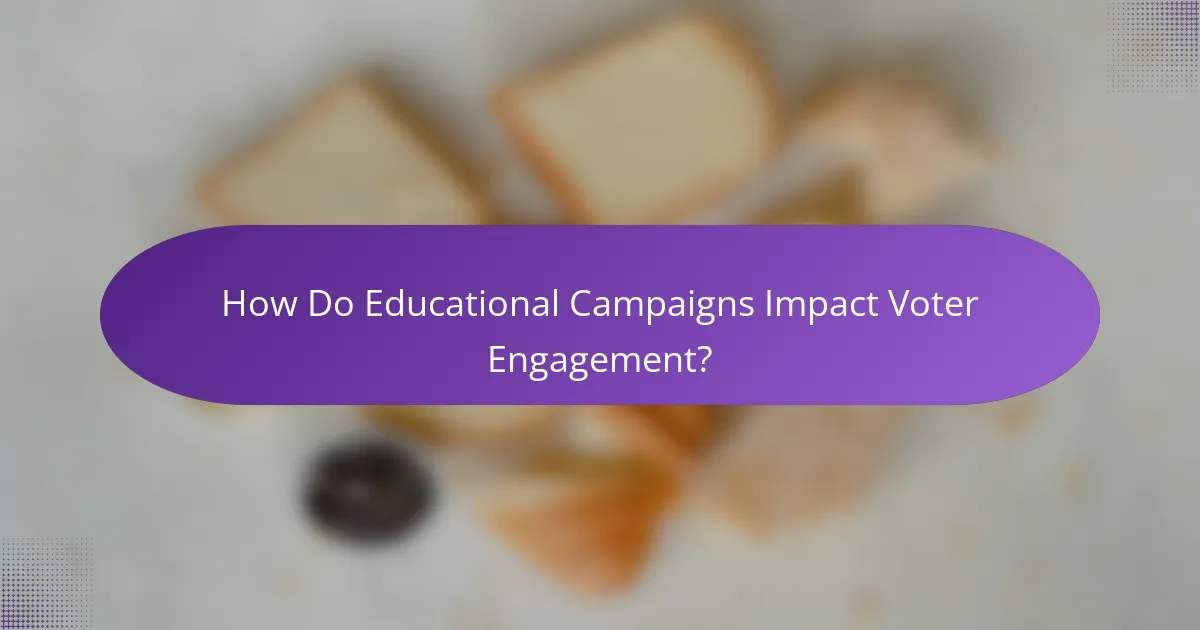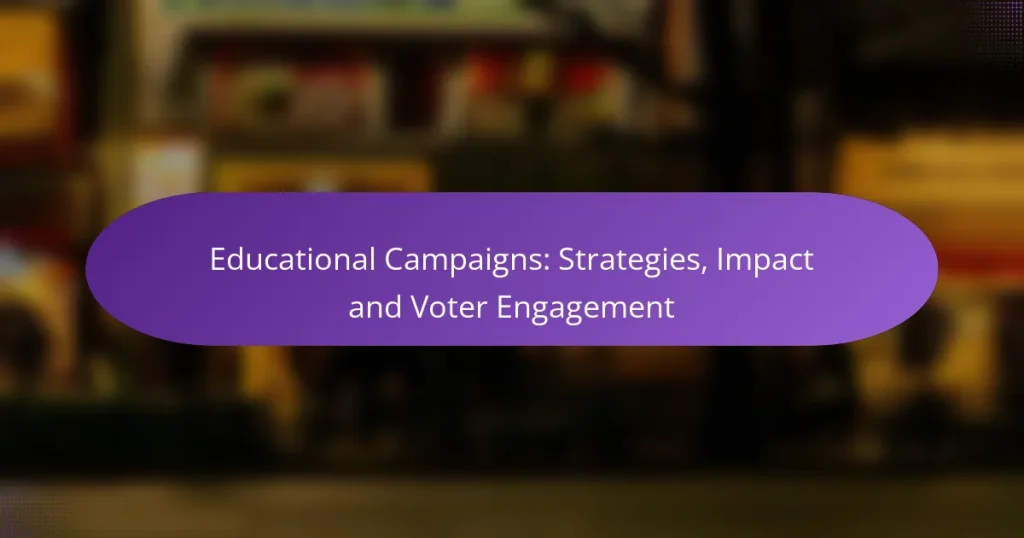Educational campaigns play a crucial role in enhancing voter engagement by providing essential information about the voting process and the issues at stake. By employing targeted messaging, community involvement, and digital outreach, these campaigns effectively mobilize diverse audiences and foster informed participation in democratic processes. Measuring their success through voter turnout and social media engagement helps refine strategies for future initiatives.

What Strategies Enhance Educational Campaigns in the US?
Effective educational campaigns in the US utilize a combination of targeted messaging, community engagement, digital outreach, partnerships with local organizations, and social media strategies. These approaches help to inform and mobilize voters, ensuring that educational content resonates with diverse audiences.
Targeted Messaging
Targeted messaging involves tailoring communication to specific demographics based on factors like age, location, and interests. This strategy increases the relevance of the information presented, making it more likely to engage the intended audience.
For example, using language and examples that resonate with younger voters can enhance their understanding of issues that matter to them, such as student debt or climate change. Campaigns should analyze data to identify key segments and craft messages that address their unique concerns.
Community Engagement
Community engagement focuses on building relationships within local populations to foster trust and participation. This can include hosting town hall meetings, workshops, or informational sessions that encourage dialogue and feedback.
Engaging with community leaders and influencers can also amplify the campaign’s reach. By involving local voices, campaigns can create a sense of ownership and investment in the educational content being shared.
Digital Outreach
Digital outreach leverages online platforms to disseminate educational materials widely and efficiently. This includes email campaigns, webinars, and informative websites that provide easy access to important information.
Utilizing analytics tools can help campaigns track engagement and adjust strategies accordingly. For instance, if a particular topic garners significant interest, campaigns can create more content around that subject to maintain momentum.
Partnerships with Local Organizations
Forming partnerships with local organizations can enhance the credibility and reach of educational campaigns. Collaborating with schools, non-profits, and civic groups can provide access to established networks and resources.
These partnerships can facilitate joint events or co-branded materials, making it easier to reach target audiences. It’s essential to ensure that all partners share a common goal and messaging to maintain consistency.
Utilizing Social Media Platforms
Social media platforms are powerful tools for engaging voters and spreading educational content. Campaigns should identify which platforms are most popular among their target demographics and tailor content accordingly.
Regular posting, interactive content like polls or quizzes, and engaging visuals can significantly enhance visibility and interaction. Campaigns should also monitor social media trends to adapt their strategies and stay relevant in conversations that matter to voters.

How Do Educational Campaigns Impact Voter Engagement?
Educational campaigns significantly enhance voter engagement by informing the electorate about the voting process, issues at stake, and the importance of participation. These campaigns can lead to higher turnout, better-informed voters, and increased community involvement in democratic processes.
Increased Voter Turnout
Educational campaigns can lead to increased voter turnout by motivating individuals to participate in elections. By providing clear information about registration deadlines, polling locations, and voting methods, these campaigns help remove barriers that may prevent people from voting.
For instance, campaigns that utilize social media and community events can effectively reach younger voters, who may be less engaged. Studies suggest that targeted outreach can boost turnout by several percentage points, particularly among underrepresented groups.
Improved Voter Knowledge
Improved voter knowledge is a direct outcome of effective educational campaigns. When voters are well-informed about candidates, policies, and the electoral process, they are more likely to make educated decisions at the polls.
Campaigns that focus on simplifying complex issues and providing unbiased information can enhance understanding. For example, using infographics or community forums can clarify ballot measures, helping voters grasp their implications without overwhelming jargon.
Strengthened Community Involvement
Educational campaigns foster strengthened community involvement by encouraging civic participation beyond just voting. When individuals are educated about the political process, they are more likely to engage in discussions, attend town hall meetings, and advocate for local issues.
Moreover, campaigns that partner with local organizations can create a network of engaged citizens. This collaboration not only boosts voter turnout but also builds a sense of community ownership over local governance, leading to more active participation in civic life.

What Are the Key Metrics for Measuring Campaign Success?
Key metrics for measuring campaign success include voter participation rates, engagement on social media, and feedback from surveys. These indicators help assess the effectiveness of educational campaigns in mobilizing voters and shaping public opinion.
Voter Participation Rates
Voter participation rates indicate the percentage of eligible voters who actually cast their ballots during an election. A successful campaign typically aims for participation rates above the national average, which can vary widely by region and election type.
To improve participation, campaigns can focus on targeted outreach, such as door-to-door canvassing or community events. Tracking registration numbers and turnout can provide insights into which strategies are most effective.
Engagement on Social Media
Engagement on social media measures how actively users interact with campaign content through likes, shares, comments, and overall reach. High engagement levels often correlate with increased awareness and interest in the campaign’s message.
To enhance social media engagement, campaigns should create shareable content, utilize hashtags, and encourage user-generated content. Monitoring engagement metrics can help refine strategies and identify the most resonant messages.
Feedback from Surveys
Feedback from surveys provides direct insights into voter attitudes and perceptions regarding the campaign. Surveys can assess message clarity, voter concerns, and overall satisfaction with the campaign’s efforts.
Conducting pre- and post-campaign surveys can help gauge shifts in public opinion and identify areas for improvement. It’s essential to ensure that surveys are representative and cover diverse demographics to capture a comprehensive view of voter sentiment.

What Tools Can Optimize Campaign Strategies?
To optimize campaign strategies, leveraging the right tools can significantly enhance engagement and effectiveness. Tools like Canva, Mailchimp, and Google Analytics provide essential functionalities that streamline processes and improve outreach.
Canva for Visual Content
Canva is a user-friendly design platform that enables campaign teams to create visually appealing graphics and materials. With a wide range of templates tailored for social media, flyers, and infographics, it allows users to maintain brand consistency while saving time.
When using Canva, consider the dimensions and formats suitable for each platform to maximize visibility. For instance, Instagram posts typically require square images, while Facebook banners need a rectangular layout. A well-designed visual can increase engagement rates by attracting more viewers.
Mailchimp for Email Campaigns
Mailchimp is a powerful tool for managing email campaigns, allowing organizations to reach their audience effectively. It offers customizable templates, automation features, and audience segmentation, which can help tailor messages to different voter demographics.
To get the most out of Mailchimp, focus on crafting compelling subject lines and clear calls to action. Regularly analyze open and click-through rates to refine your approach. Avoid sending too many emails in a short period, as this can lead to higher unsubscribe rates.
Google Analytics for Performance Tracking
Google Analytics provides insights into website traffic and user behavior, essential for assessing the effectiveness of campaign strategies. By tracking metrics such as page views, bounce rates, and user demographics, campaigns can be adjusted based on real data.
When setting up Google Analytics, ensure that goals are defined clearly to measure conversions effectively. Regularly review reports to identify trends and areas for improvement. Utilizing UTM parameters can also help track the performance of specific campaigns across different channels.

What Are the Prerequisites for Effective Campaign Planning?
Effective campaign planning requires a clear understanding of objectives, target audience, and resources. Establishing these prerequisites ensures that campaigns are strategically aligned and can maximize their impact on voter engagement.
Understanding Your Target Audience
Identifying and understanding your target audience is crucial for effective campaign planning. This involves researching demographics, interests, and voting behaviors to tailor your messaging and outreach strategies. Utilize surveys, focus groups, and social media analytics to gather insights.
Consider segmenting your audience into groups based on factors like age, location, and political affiliation. This allows for more personalized communication, increasing the likelihood of engagement. For example, younger voters may respond better to digital campaigns, while older demographics may prefer traditional methods.
Setting Clear Objectives
Clear objectives guide the direction of your campaign and help measure success. Objectives should be specific, measurable, achievable, relevant, and time-bound (SMART). For instance, aiming to increase voter registration by a certain percentage within a defined timeframe provides a focused goal.
Regularly review and adjust your objectives based on campaign performance and feedback. This adaptability can enhance effectiveness and ensure that resources are allocated efficiently. Prioritize objectives that align with both your campaign’s mission and the needs of your target audience.
Resource Allocation
Effective resource allocation is essential for executing a successful campaign. This includes budgeting for advertising, staffing, and materials. Establish a budget that reflects your campaign goals and consider potential funding sources, such as donations or grants.
Evaluate the skills and expertise of your team to assign roles effectively. For example, if your campaign relies heavily on social media, ensure you have team members proficient in digital marketing. Regularly assess resource utilization to avoid waste and maximize impact.
Compliance with Regulations
Understanding and complying with local regulations is a critical aspect of campaign planning. Familiarize yourself with election laws, including fundraising limits and advertising guidelines. Non-compliance can lead to penalties and undermine your campaign’s credibility.
Consult legal experts or resources specific to your region to ensure adherence to all regulations. In the United States, for example, the Federal Election Commission (FEC) provides guidelines that campaigns must follow. Staying informed helps maintain transparency and trust with voters.


